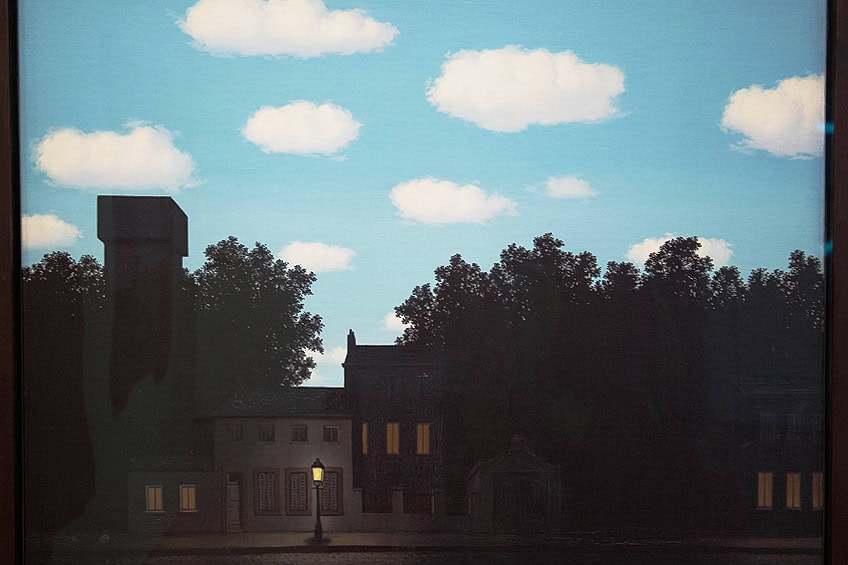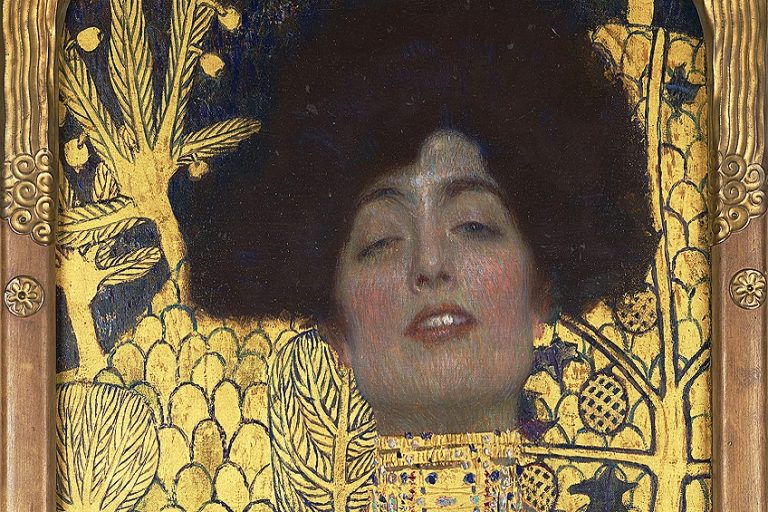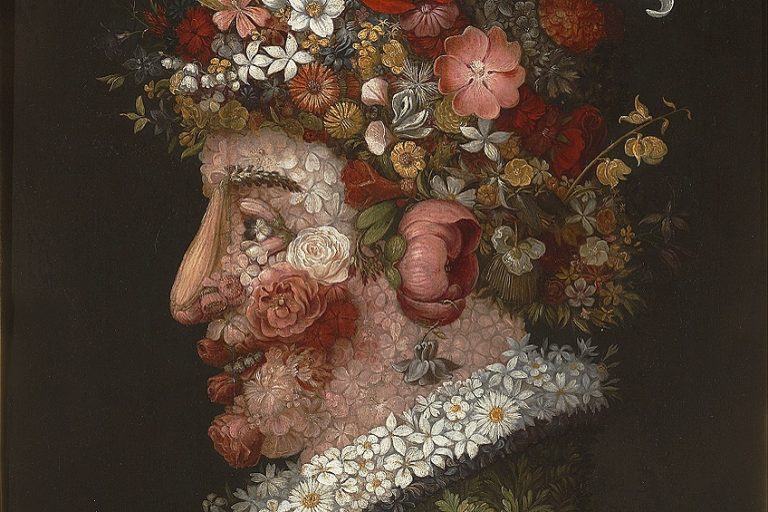“The Empire of Light” by René Magritte – The Art of Juxtaposition
The Empire of Light by René Magritte is a quintessential example of the Belgian surrealist’s ability to juxtapose the ordinary with the extraordinary, creating scenes that challenge the viewer’s perception of reality. Painted in between 1939 and 1967, this series of paintings depicts a serene, daylit sky above a nocturnal street, merging contradictory elements in a single frame. Magritte’s masterful use of light and shadow, combined with his characteristic precision, evokes a sense of dreamlike mystery and poetic ambiguity. The Empire of Light invites viewers to question the nature of reality and perception, making it a landmark piece in the surrealist movement.
Key Takeaways
- René Magritte’s The Empire of Light is a celebrated series that merges day and night into a single scene, questioning perceptions of reality.
- The series consists of 27 works, deepening the Surrealist exploration of light, darkness, and time across various individual paintings.
- Magritte’s legacy persists through the profound cultural impact of his works and their presence in exhibitions worldwide, reflecting the enduring fascination with Surrealist art.
The Making of The Empire of Light
| Artist | René Magritte (1898 – 1967) |
| Date Created | c. 1939 – 1967 |
| Medium | Oil on canvas and gouache on paper |
| Genre | Surrealism |
| Period/Movement | Surrealism |
| Dimensions (cm) | Varies by version |
| Series/Versions | Multiple versions |
| Where Is It Housed? | Various museums, including the Museum of Modern Art in New York, the Menil Collection in Houston, and the Royal Museums of Fine Arts of Belgium in Brussels |
| What It Is Worth | Individual paintings have sold for over $20 million at auction; total series value is considerably higher |
The Empire of Light stands as one of the most iconic series of paintings in the history of art, created by the renowned Surrealist Belgian artist René Magritte. Captivating the art world with its juxtaposition of day and night, the paintings feature a serene daytime sky over a dark, nocturnal landscape. This enigmatic visual paradox presents a challenge to viewers’ perceptions of reality and nature’s dichotomies. René Magritte’s exploration of light and darkness across these works, created between 1939 and 1967, exemplifies Surrealism’s quest to bridge the gap between the unconscious and conscious experiences.
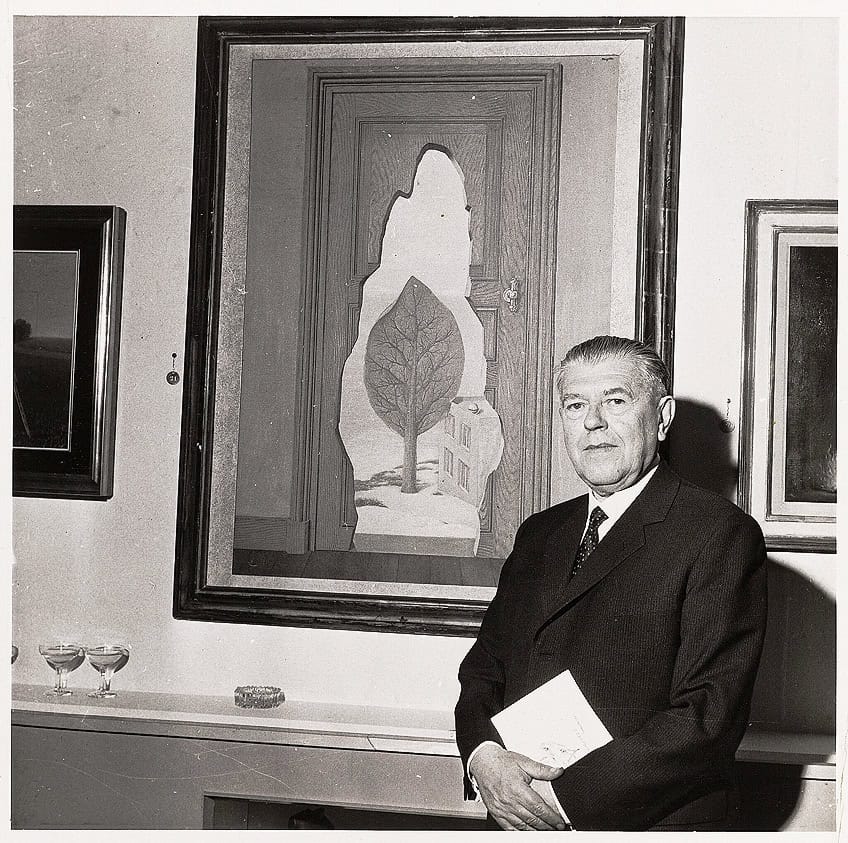
Comprising 17 oil paintings and 10 gouaches, Magritte did not initially intend for these works to form a series. Each painting, while sharing a common theme, invites a unique introspection into the mysteries of time, light, and the limits of human understanding. The Empire of Light celebrates the painter’s technical mastery in oil on canvas, amplifying the contrasts inherent in our daily existence and challenging audiences to seek meaning beyond the visible.
Inspirations and Influences
Magritte’s work was profoundly influenced by the key principles of Surrealism, a movement deeply intertwined with the works of French Surrealists and the writings of André Breton. During the time in which The Empire of Light was created, the aftermath of the Second World War cast a shadow on European art and philosophy, prompting artists to search for meaning beyond the visible, tangible world.
Magritte, along with his contemporaries, sought to explore the unconscious mind, dreaming states, and the irrationality of existence.
Technique and Composition
René Magritte executed The Empire of Light in oil on canvas, a traditional medium that allowed him to achieve a high level of detail and a delicate gradient of hues necessary to convey the subtle shifts between light and darkness, as well as gouache. His technique involved the careful layering of paint to create the luminous sky and the contrasting shadows of the nighttime landscape below. The series displays a meticulous control of composition through bold Juxtaposition (daytime skies above nocturnal landscapes) and Realism (highly realistic depictions imbued with startling contradiction). Magritte’s The Empire of Light invites the viewer to consider the dualities of existence and to question the nature of perception and reality.
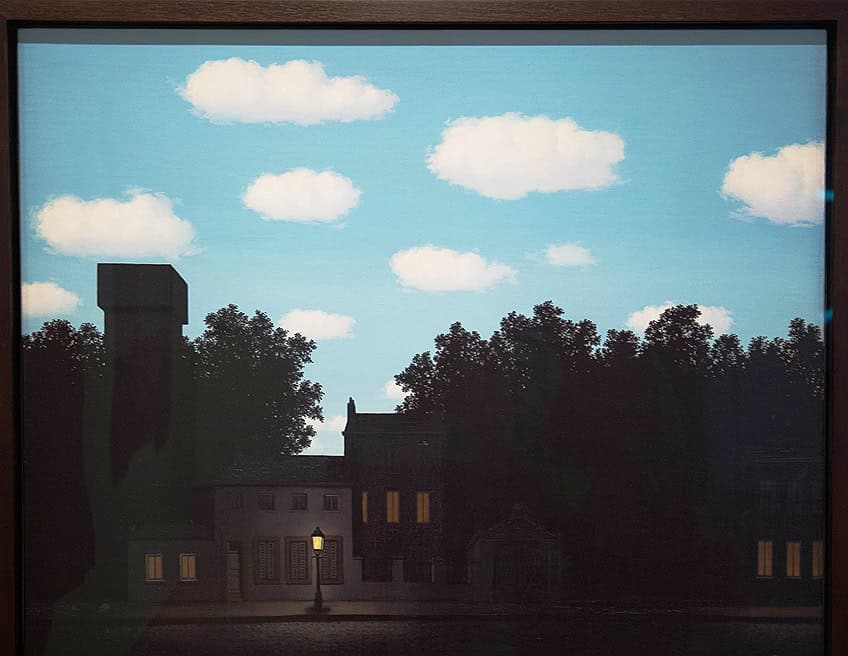
Thematic Analysis
René Magritte’s The Empire of Light skillfully bridges the realms of dream and reality through its powerful visuals, presenting a paradox that merges the conscious with the unconscious.
Contrast Between Dream and Reality
Magritte’s series, The Empire of Light, presents a juxtaposition that confuses the mind on first glance. The daytime sky sits incongruously above a nighttime streetscape, blending the boundaries between waking reality and the dream world. This combination invokes a sense of unease as it compels viewers to question their perception of reality. By merging opposite times of day, Magritte emphasizes the surrealist concept where dreams can coexist with reality.
Interplay of Light and Darkness
The signature element of The Empire of Light revolves around its exploration of light and darkness. The single illuminated streetlight serves as a beacon in the night, a stark point of brightness against the encroaching dark. This creates a visual poetry that is emblematic of Magritte’s work, crafting a mystery that hints at deeper truths sheltered in the unconscious mind.
It suggests an allegory for the human condition, where light—representative of knowledge and enlightenment—clashes with the darkness of ignorance and fear.
Artistic Analysis
René Magritte’s The Empire of Light masterfully juxtaposes day and night, employing surreal contrasts to explore perception and reality.
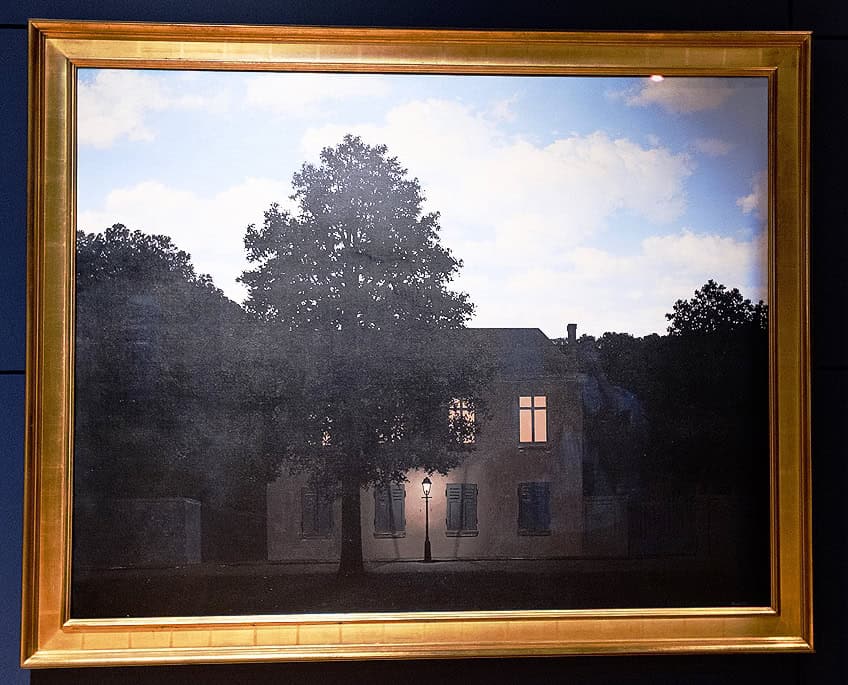
Subject Matter
The Empire of Light is a series of paintings where each piece illustrates an enigmatic scene of a nocturnal streetscape over which a brightly lit daytime sky presides. This surreal blending of night and day defies conventional time boundaries and invites viewers to question their perceptions.
Use of Color and Light
Magritte employs stark contrast in light to emphasize the surreal quality of the works. Broad daylight reigns in the sky with soft blues and fluffy clouds, while darkness envelops the houses and street below, marked by artificial light sources that pierce through the night.
The interplay of natural and artificial illumination creates a dramatic yet harmonious synergy that further intensifies the dream-like ambiance.
Meaning of the Works
The meaning behind The Empire of Light is often interpreted as a commentary on the subjective nature of reality. The paintings challenge viewers to consider how light and darkness can coexist in a single moment, a concept that can parallel with how opposing emotions or states of being intermingle in human experience.
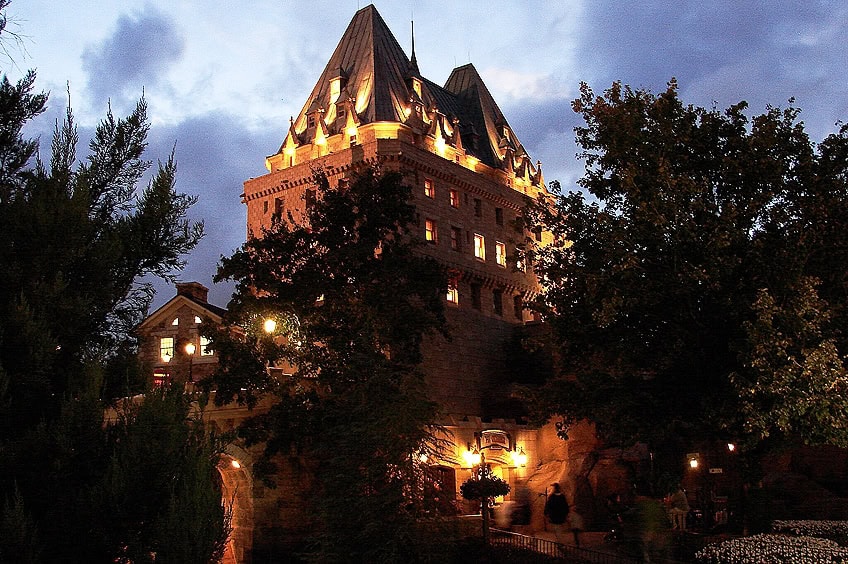
Cultural and Artistic Impact
René Magritte’s The Empire of Light series is not only a hallmark of surrealism but also a significant point of convergence between art and culture. It resonates through the realms of modern art and popular culture, showcasing a dual reality that challenges perception.
Influence on Modern Art
The Empire of Light is emblematic of Magritte’s influence on modern art, with its juxtaposition of day and night skies over a single landscape. It echoes surrealism’s aspiration to reveal the unconscious mind and has left an indelible mark on both surrealist peers and subsequent generations of artists.
For example, Max Ernst and Salvador Dalí, contemporaries of Magritte, similarly explored paradox and unconscious imagery within their work, though each with a distinct touch.
Renowned galleries such as the Peggy Guggenheim Collection have played a pivotal role in showcasing surrealism, including Magritte’s thought-provoking pieces, to a global audience. The display of such artwork continues to influence artists by challenging them to explore beyond the visible world.
Appearances in Popular Culture
Magritte’s The Empire of Light transcends the boundaries of art history to make appearances in various facets of popular culture. The series has significantly impacted films, specifically the horror genre. In the classic horror film, The Exorcist, the character Father Merrin is introduced with the backdrop of a street lamp that seems to reference the surreal, twilight mood of Magritte’s paintings. This visual cue enhances the film’s theme of coexisting and conflicting realities—mirroring the contradicting elements of day and night found in The Empire of Light. Another dimension of its cultural impact is seen through direct references and inspirations in media such as film posters and book covers, which often mimic the painting’s eerie illumination and stark contrasts to evoke mystery and intrigue.
The painting’s motif has become a visual shorthand for signaling the surreal and unexplained, influencing both aesthetics and narratives alike. Furthermore, Magritte’s philosophical challenge to viewers’ preconceptions in another famous work titled The Treachery of Images, which features the phrase “Ceci n’est pas une pipe” (This is not a pipe), can be seen as an undercurrent in the way The Empire of Light encourages the audience to question what is real.
This notion permeates popular culture, fostering a critical view of the obvious and a deeper search for meaning.
Legacy and Exhibition History
René Magritte’s The Empire of Light stands as a remarkable testament to the surreal juxtapositions that characterize his body of work. Displayed in prominent institutions and revered in art circles, the painting’s enigmatic imagery has secured its place in the annals of fine art.
Ownership and Display
The Empire of Light series encapsulates a unique blend of day and night across multiple canvases, a motif that has intrigued audiences and curators alike. One prominent version of the painting, The Empire of Light, II, painted in 1950, resides in the Museum of Modern Art (MoMA) in New York as part of its esteemed collection. It was a gift from Dominique and John de Menil, marking a significant addition to MoMA’s Department of Painting and Sculpture. MoMA routinely showcases this piece in exhibitions, ensuring that Magritte’s work remains accessible to the public.
Several other pieces from the series are held at various institutions, including the Royal Museums of Fine Arts of Belgium, signifying the country’s pride in one of its most illustrious painters.
Art Prints and Reproduction
Reproductions of The Empire of Light are widespread, attesting to the enduring popularity of Magritte’s work. Art enthusiasts who contact galleries and museums, such as the Art Renewal Center or MoMA’s Archives and Staff, can often find high-quality prints available for purchase. Additionally, art galleries and vendors reproduce the iconic scene across a variety of media, from posters to canvas prints. The imagery, while reserved for picturesque depictions in Magritte’s oeuvre, has been faithfully reproduced to allow wider audiences the chance to engage with this surreal masterpiece.

René Magritte’s The Empire of Light series remains a testament to the surrealist’s genius in blending the familiar with the uncanny. Through these paintings, Magritte masterfully disrupts conventional expectations of time and space, inviting viewers into a world where day and night coexist in harmony. This paradoxical imagery not only captivates the eye but also stimulates deeper contemplation about the nature of reality and our perception of it. By merging the ordinary with the extraordinary, Magritte’s The Empire of Light continues to inspire and intrigue, solidifying its place as a cornerstone of surrealist art and a profound exploration of the mysteries of the human mind.
Frequently Asked Questions
What Is the Significance Behind René Magritte’s The Empire of Light Series?
The Empire of Light series is significant for its exploration of reality and perception, where Magritte plays with the concept of time by presenting contradictory elements—day and night—in a single image. This surreal juxtaposition invites viewers to question their assumptions about the natural world.
Can You Explain the Meaning of Day and Night Juxtaposition in The Empire of Light?
In The Empire of Light, the day and night juxtaposition creates a visual paradox, challenging the viewer’s preconceived notions of reality. Magritte’s intent is to provoke thought and reflect on the mysterious nature of the everyday by combining a bright, daytime sky with a darkened, nocturnal landscape.
How Many Paintings Are in The Empire of Light Series and Do They Differ?
There are 27 paintings within The Empire of Light series, consisting of 17 oil paintings and 10 gouaches. While all share the theme of contrast between daylight and darkness, each painting varies slightly in composition and mood, thereby allowing Magritte to thoroughly explore the motif.
What Artistic Technique Did Magritte Employ in The Empire of Light to Achieve the Surreal Effect?
Magritte used traditional oil painting techniques to achieve the surreal effect in The Empire of Light. His precise and meticulous approach resulted in scenes with photographic realism that, when combined with the conceptual paradox, contribute to the dream-like atmosphere typical of his work.
Isabella studied at the University of Cape Town in South Africa and graduated with a Bachelor of Arts majoring in English Literature & Language and Psychology. Throughout her undergraduate years, she took Art History as an additional subject and absolutely loved it. Building on from her art history knowledge that began in high school, art has always been a particular area of fascination for her. From learning about artworks previously unknown to her, or sharpening her existing understanding of specific works, the ability to continue learning within this interesting sphere excites her greatly.
Her focal points of interest in art history encompass profiling specific artists and art movements, as it is these areas where she is able to really dig deep into the rich narrative of the art world. Additionally, she particularly enjoys exploring the different artistic styles of the 20th century, as well as the important impact that female artists have had on the development of art history.
Learn more about Isabella Meyer and the Art in Context Team.
Cite this Article
Isabella, Meyer, ““The Empire of Light” by René Magritte – The Art of Juxtaposition.” Art in Context. May 28, 2024. URL: https://artincontext.org/the-empire-of-light-by-rene-magritte/
Meyer, I. (2024, 28 May). “The Empire of Light” by René Magritte – The Art of Juxtaposition. Art in Context. https://artincontext.org/the-empire-of-light-by-rene-magritte/
Meyer, Isabella. ““The Empire of Light” by René Magritte – The Art of Juxtaposition.” Art in Context, May 28, 2024. https://artincontext.org/the-empire-of-light-by-rene-magritte/.


